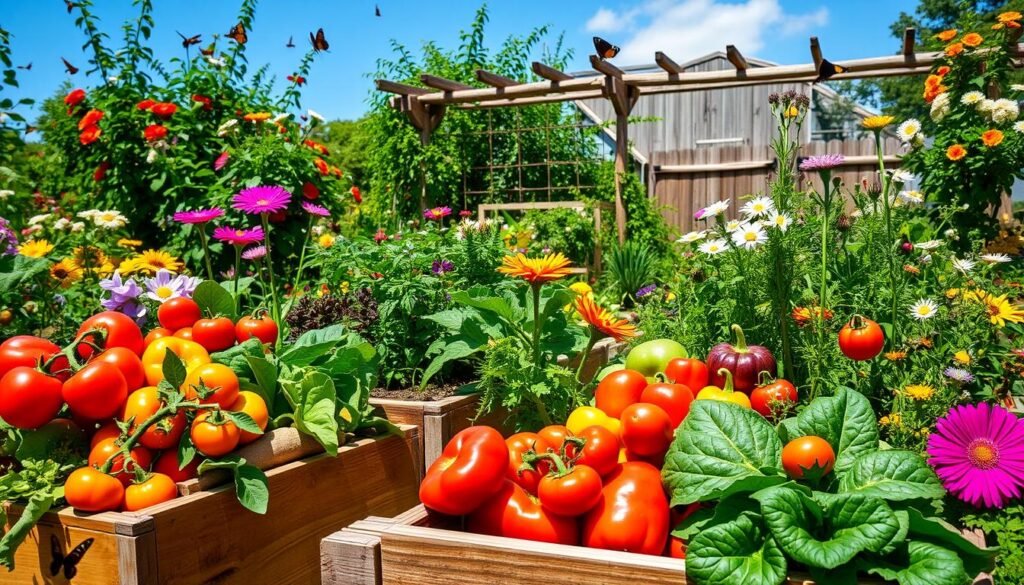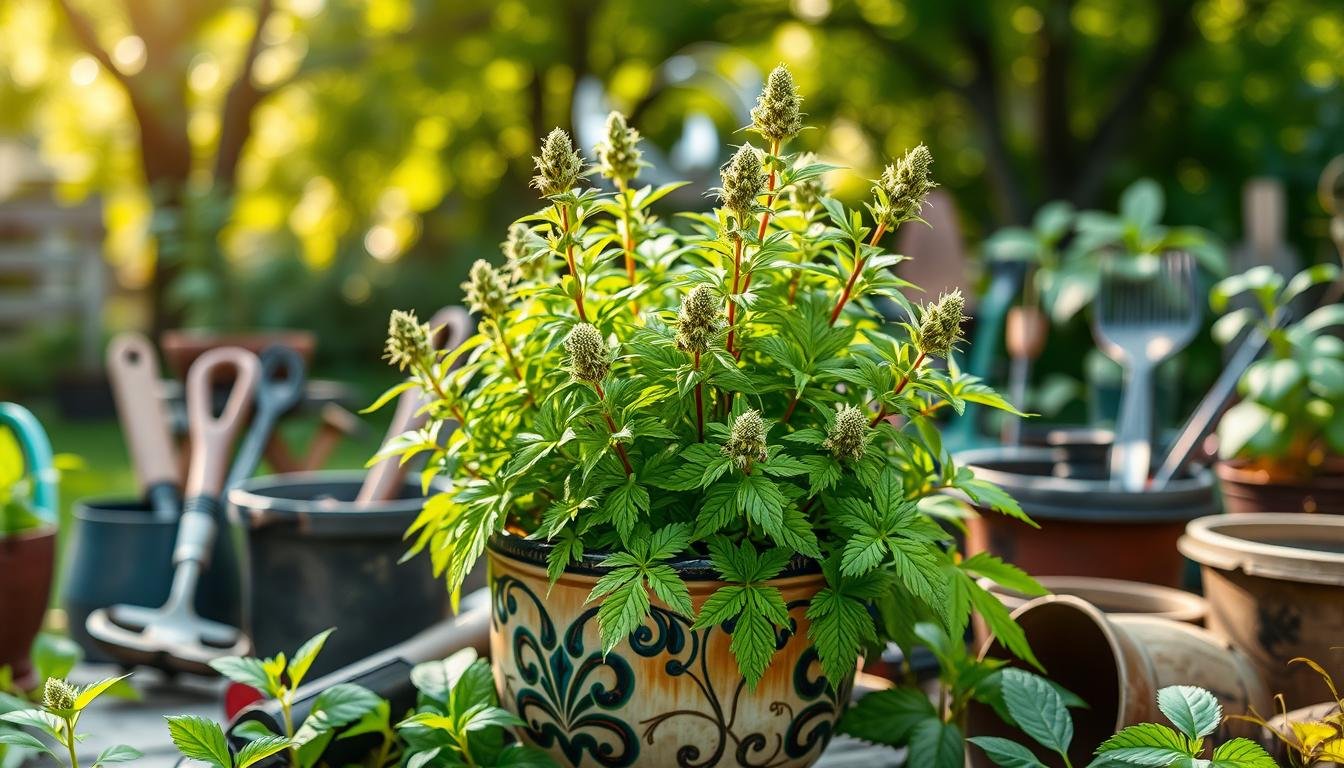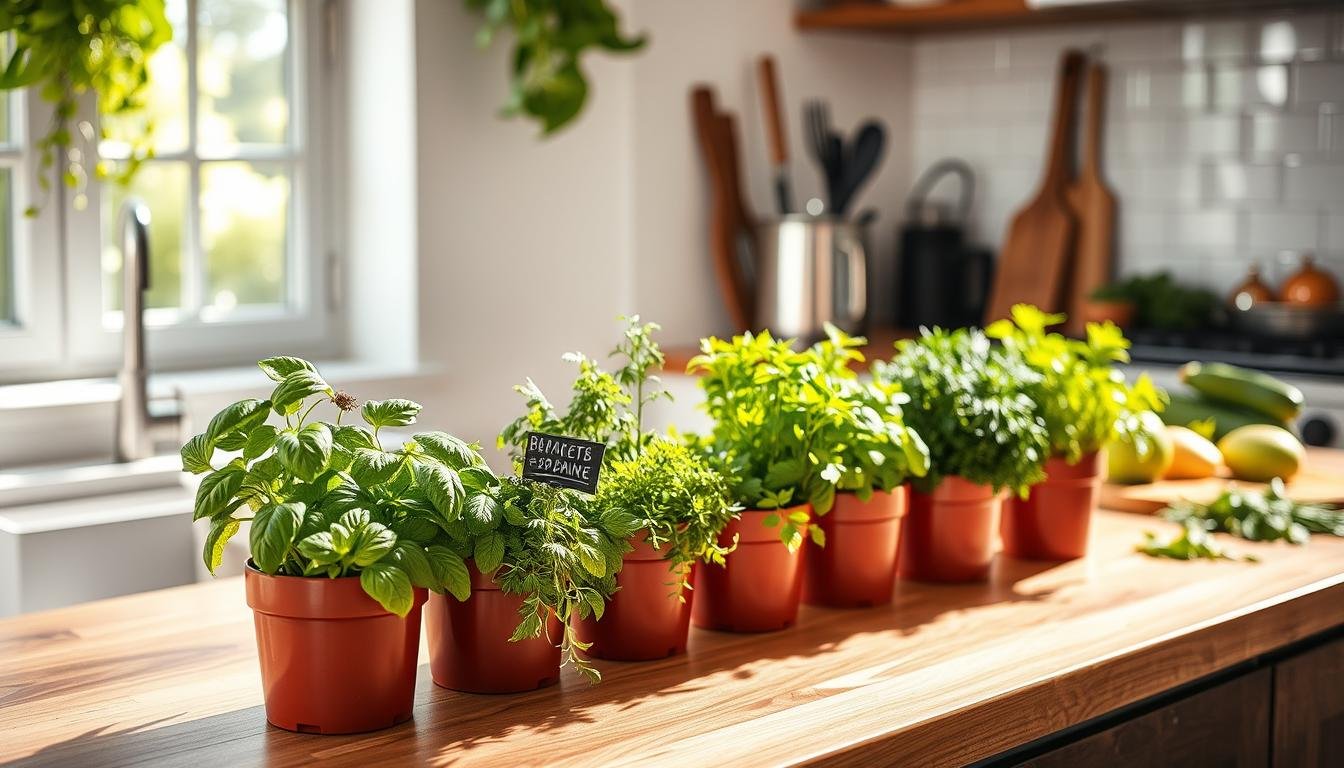Did you know more than one-third of U.S. homes are into gardening? This isn’t just for fun. It’s becoming a way for people to live self-sufficiently and stay healthy. Home vegetable gardening is now easy for beginners. You don’t need much experience. You can grow fresh veggies whether you have a lot of space or just a tiny balcony. Here are some simple guidelines to help you start your vegetable garden confidently!
Key Takeaways
- Gardening is a popular activity, with over 35% of U.S. households participating.
- Home vegetable gardening is accessible for beginners and allows for fresh produce at home.
- Easy gardening tips can help you succeed, regardless of space limitations.
- Engaging in vegetable gardening promotes sustainability and personal wellness.
- Starting a home vegetable garden can foster a deeper connection with food.
Why Start a Home Vegetable Garden?
Starting a home vegetable garden gives you control of your food sources. It’s a rewarding activity that boosts food security and enriches our lives. It also brings many benefits to the environment.
Benefits of Growing Your Own Vegetables
Growing your own veggies means you get fresh, high-quality produce. Homegrown vegetables taste better and are more nutritious than those from stores. By choosing heirloom or organic seeds, you know what’s in your food. This practice cuts out preservatives and artificial additives, making it healthier for your family.
Sustainability and Freshness
Home gardening is great for the planet. It supports sustainable food practices, reduces food miles, and cuts down on waste. This helps local wildlife and bees too. The USDA says gardening at home helps communities and lessens our carbon footprint. It creates a better environment for all of us.
Choosing the Right Location for Your Garden
Choosing the right spot for your vegetable garden is key. It needs enough sunlight and space for your plants to grow. Plants need sunlight and room to turn out well.
Knowing how much sun veggies need helps you plan your garden. This makes sure they grow right.
Sunlight Requirements for Vegetable Growth
Vegetables generally need 6-8 hours of direct sunlight daily. This sunlight is vital for their growth. It powers photosynthesis. So, pick a spot that gets plenty of sun.
Watch out for shade from trees, buildings, or fences. They can block sunlight. Checking sunnier spots in your area helps you know where to plant.
Assessing Your Space: Yard vs. Balcony
In cities, gardening requires clever use of small spaces. Yards offer more room than balconies. But balcony gardeners can still grow lots, using containers or vertical gardens.
It’s important to consider how much sun your space gets. Make sure your gardening spot fits your needs. This could be lots of sunlight or good air flow.
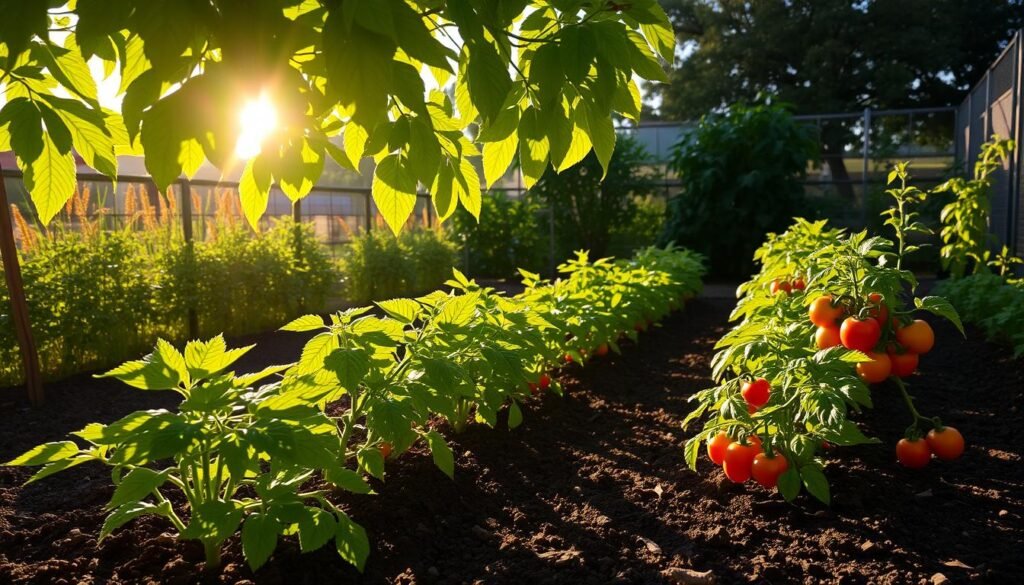
Home Vegetable Garden Ideas: Types of Gardens to Consider
Starting a garden journey opens up a world of inspiration. Different types of home vegetable gardens offer unique benefits. They let beginners pick what best suits their lifestyle and space.
Let’s dive into three gardening methods to boost your growing experience.
Raised Garden Beds
Raised bed gardening is perfect for beginners. It lifts soil above ground, improving drainage and soil control. This makes taking care of plants easier.
It also allows for an organized garden that uses space well. This method is great for growing a variety of vegetables.
Container Gardening
Container gardening offers flexibility and invites creativity. You can grow plants in pots which is great for limited spaces like balconies. You can mix herbs and veggies in different pot sizes.
This method also brings beauty to your space with colorful pots.
Vertical Gardening
Vertical gardening is a smart pick for those with less room. It uses wall planters or trellises to grow plants up, not out. This saves space and helps plants stay healthy with better air flow.
Essential Tools and Supplies for Beginners
Gardening is fun and rewarding, especially with the right tools. Knowing the key supplies helps beginners start strong. It’s easier to garden and see success with the right tools.
Choosing the Right Tools
For new gardeners, choosing the right tools is key. Here are some essential tools:
- Trowel: Perfect for digging, planting, and loosening soil.
- Pruners: Great for trimming and shaping plants for better growth.
- Gloves: Protect your hands from thorns and dirt.
- Rake: Helpful for leveling soil and gathering debris.
- Watering Can: Essential for effectively watering plants.
These tools make gardening easier and more fun for beginners.
Soil and Fertilizers Overview
Choosing the right soil is crucial for plant success. Consider this:
- Loamy Soil: Best for most vegetables, as it keeps moisture but drains well.
- Sandy Soil: Drains well but may need more nutrients.
- Clay Soil: Holds nutrients well but might need better aeration.
Also, knowing about fertilizers is important for your plants’ nutrition. Check this out:
| Fertilizer Type | Description | Best For |
|---|---|---|
| Organic | Made from natural materials, improves soil structure. | All types of plants, especially vegetables. |
| Synthetic | Fast-acting nutrients, tailored for specific plant needs. | Quick growth for seasonal vegetables. |
Choosing the right soil and fertilizers is key to a beautiful vegetable garden.
Selecting the Best Vegetables for Your Garden
Choosing the right plants is crucial for those new to gardening. Many beginners want simple-to-grow veggies that also yield plenty of food. Going for easy vegetables can make gardening more fun and satisfying.
Popular Choices for Beginners
Some vegetables are especially good for beginners due to their hardiness. Here are a few:
- Tomatoes: They have a great taste and can grow under many conditions.
- Peppers: Easy to grow, these come in sweet and spicy varieties with low upkeep.
- Lettuce: It sprouts quickly and loves cooler weather.
- Radishes: A fast grower, you can harvest them in just weeks.
Growing Organic Vegetables
Growing veggies organically means relying on natural ways to raise your plants. This supports a healthy environment and results in better-tasting food. Starting with organic or heirloom seeds makes your garden stand out. Going organic offers perks like:
- No synthetic pesticides or fertilizers.
- Healthier soil and more plant variety.
- Tastier and more nutritional vegetables.
Using organic gardening methods brings you closer to nature. With the right vegetable choices and organic approaches, you can create a lush vegetable garden at home.
| Vegetable | Days to Harvest | Growing Season |
|---|---|---|
| Tomatoes | 60-80 | Warm |
| Peppers | 70-90 | Warm |
| Lettuce | 30-60 | Cool |
| Radishes | 25-30 | Cool |
The Basics of Planting Your Garden
To create a thriving vegetable garden, understanding basic planting is key. Grasping essential tips helps beginners do well. This involves knowing how deep to plant vegetables and how far apart they should be. These steps let plants grow their best.
Understanding Planting Depth and Spacing
Every vegetable needs to be planted at a certain depth to grow well. Below, a table shows the average depth and how far apart to plant:
| Vegetable | Planting Depth (inches) | Spacing (inches) |
|---|---|---|
| Carrots | 0.5 | 2 |
| Tomatoes | 2 | 24 |
| Lettuce | 0.5 | 12 |
| Cucumbers | 1 | 36 |
| Beans | 1-2 | 4 |
Timing Your Planting for Success
When you plant can really affect how your garden does. The local weather and seasons are key to picking the right time. The USDA Plant Hardiness Zone Map can guide you in scheduling your vegetable plants. Watching the weather and checking the soil can help your veggies thrive, just like the planting tips for beginners say.
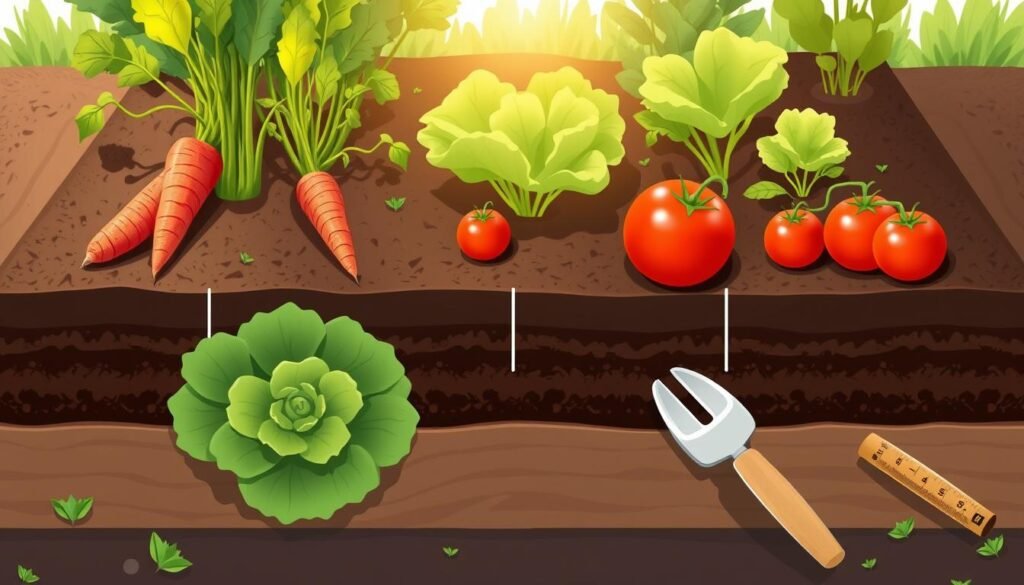
Square Foot Gardening: A Beginner-Friendly Method
Square foot gardening is a unique, space-saving way to garden. It’s perfect for those starting out. This method breaks the garden into one-foot square sections. This makes it easy to organize and manage plants.
This technique is structured, making it easy for beginners. You have defined spaces for each type of plant. This helps with crop rotation and soil quality. The Square Foot Gardening Foundation offers great tips and guidelines.
Many gardeners love square foot gardening because it simplifies things. Each square can have a different plant, offering variety. It’s a great way to start gardening without feeling overwhelmed by big plots.
| Advantages | Description |
|---|---|
| Maximized Yield | Utilizes limited space efficiently, producing more vegetables per square foot. |
| Easy Maintenance | Reduces the time and effort spent on upkeep due to minimized weeding and watering. |
| Variety of Plants | Allows for a diverse selection of plants in a compact area, catering to various tastes. |
| Environmental Benefits | Optimizes resource use, contributing to sustainable gardening practices. |
Implementing Companion Planting Techniques
Companion planting is a useful gardening approach. It involves placing certain plants together to boost their growth. This method can lead to better nutrient absorption and natural pest control. Gardeners who use companion planting can enjoy a healthier, more productive garden. They will also appreciate the many companion planting benefits.
Benefits of Companion Planting
Companion planting makes your garden healthier. It allows plants to help each other grow better and produce more. Notable benefits include:
- Natural pest deterrence: Some plants can keep harmful insects away from other plants.
- Improved nutrient absorption: Certain plant combinations use soil nutrients more effectively.
- Enhanced pollination: Some pairs of plants can attract helpful pollinators, improving crop yield.
Examples of Effective Plant Partnerships
Choosing the right companion plants is crucial for garden health. Here are some great pairings to consider:
- Tomatoes and Basil: They work together to improve taste and keep pests away.
- Carrots and Onions: This mix confuses pests, protecting both plants.
- Cucumbers and Nasturtiums: Nasturtiums draw pests away from cucumbers, acting as a decoy.
Knowing about effective plant pairings can help gardeners create vibrant gardens. By using companion planting, you can harness nature’s aid. This way, your garden will be more abundant and eco-friendly.
Caring for Your Vegetable Garden: Tips for Success
Caring for your vegetable garden is key to a fruitful harvest. Maintaining your garden well, with the right watering practices and pest control, can boost growth and production.
Watering Guidelines
Proper watering supports healthy root growth without drowning the plants. It’s best to water deeply once or twice a week, depending on the weather. This keeps the soil moist, promoting strong plants. But, make sure the soil isn’t constantly wet. Drip irrigation is a smart choice for getting water right to the roots. Here are the top watering tips:
| Watering Method | Frequency | Benefits |
|---|---|---|
| Drip Irrigation | Once a week | Efficient, reduces disease risk |
| Soaker Hoses | Every 2-3 days | Even moisture distribution |
| Hand Watering | As needed | Allows for close monitoring |
Understanding Weeding and Pest Control
Weeding and pest control are crucial for a healthy garden. By pulling weeds regularly, you cut down on competition for resources. Using mulch helps stop weeds and keeps the soil moist. To fight pests, try integrated pest management (IPM) strategies, such as:
- Monitoring for pests regularly
- Encouraging beneficial insects, like ladybugs
- Using organic repellents when needed
- Companion planting to keep pests away
Harvesting and Enjoying Your Homegrown Vegetables
Harvesting vegetables from your own backyard is thrilling. You pick ripe tomatoes, crisp cucumbers, and sweet bell peppers. Knowing when to harvest improves flavor, with veggies tasting best at their peak. For example, pick tomatoes when fully colored and slightly soft. Zucchini should be small and tender.
Using fresh produce from your garden opens up new cooking possibilities. Cooking with homegrown ingredients boosts meal flavor. It also connects your gardening work with your cooking. Imagine sautéing fresh kale or making a salad with garden lettuce. These actions show the real benefits of home gardening.
Sharing your garden’s produce with others makes gardening even more joyful. You might host a barbecue with your veggies or give some to a neighbor. Sharing helps build relationships and creates memories. It shows how gardening is about more than just growing food. It’s about community.
